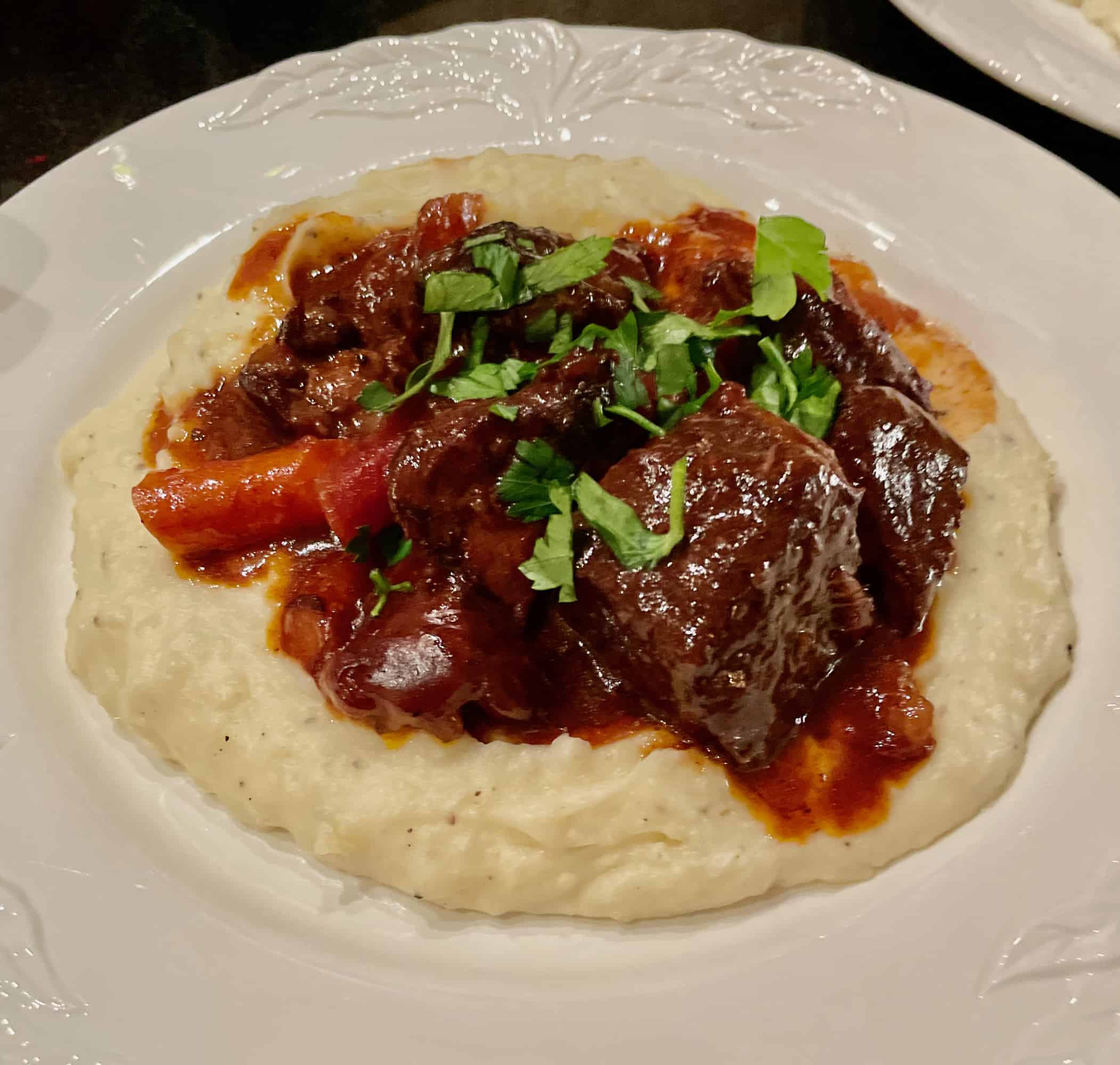
This great stew has a surprise ingredient we weren’t entirely sure about.

Our friend Roger is a great home cook. And after our Top Ten Stews post, (https://chewingthefat.us.com/2022/01/our-top-ten-stews-perfect-for-cold-winter-nights.html) Roger sent us this recipe, so we knew it had to be good. Lots and lots of onions are combined with meaty boneless beef chuck, good red wine, tomatoes, and carrots in what becomes a silken, rich sauce that clings to every bite. But what was this about Hoison Sauce? Fragrant, pungent Hoison is an Asian sauce that we’ve used in stir-fries, as a marinade, and on grilled meats. Here, wouldn’t it be too salty and cloyingly sweet? But Roger had recommended it. And since he’d kept the recipe from an August 2004 issue of Bon Appetit, we had to give it a go. And we were so glad we did.

What is Hoison Sauce?
Hoisin is a key ingredient in many Chinese dishes and some Vietnamese recipes. It’s sometimes called Chinese barbecue sauce. No one’s quite sure what its origins are but we do know it is Cantonese. Since Cantonese was the predominant Chinese American cooking style, it’s been in this country for ages. The name “Hoison” comes from the Chinese word for seafood. It may, at one time have contained a seafood ingredient because it’s famous for its umani flavor. Today, Hoison doesn’t contain any seafood. What’s more, it is virtually never used with seafood so the origins of its remain one of those inscrutable mysteries of Asia.

What’s in Hoison Sauce?
Hoison is made from a combination of fermented soybean paste, garlic, vinegar, sesame oil, chiles, and a sweetener. If you look at commercial brands of Hoison like Lee Kum Kee, theirs includes sugar, water, fermented soybean paste (which contains wheat flour), salt, sweet potato powder, modified cornstarch, sesame paste, garlic, chili peppers, and ‘spices’. Since there are no animal products in it, it’s suitable for vegans and vegetarians. In a beef stew, that’s certainly not the case. And if your diet is gluten-free, look for a Soy-free version. Kikkoman makes one. With Hoison’s strong salty and slightly sweet taste, it can be overpowering. But in this recipe, there’s just a half a cup, and oh what it does for the sauce. Here’s the recipe:
Mahogany Beef Stew with Red Wine and Hoisin Sauce
Lots of onions are combined with meaty boneless beef chuck, good red wine, tomatoes and carrots in a silken, rich sauce that clings to every bite.

Ingredients
- 4 tablespoons olive oil
- 3½ pounds boneless beef chuck roast, trimmed, cut into 2½-inch pieces
- 3½ cups chopped onions
- 2 cups Cabernet Sauvignon
- 1 (14.5-ounce) can diced tomatoes with Italian herbs, undrained
- ½ cup hoisin sauce
- 2 bay leaves
- 1 pound slender carrots, peeled, cut diagonally into 1-inch lengths
- 1 tablespoon cornstarch mixed with 1 tablespoon water
- 2 tablespoons chopped fresh parsley
Directions
- Step 1 Heat 2 tablespoons oil in a heavy large pot over high heat. Sprinkle meat with salt and pepper. Add meat to the pot. Sauté until brown on all sides, about 10 minutes. Remove beef to a plate. Reduce heat to medium. Add 2 tablespoons of oil to the pot. Add onions. Sauté until golden brown, about 15 minutes. Mix meat into onions. Add 1 cup wine, tomatoes with juices, hoisin sauce, and bay leaves. Bring to boil.
- Step 2 Reduce heat to low, cover pot, and simmer for 45 minutes, stirring occasionally. Add carrots and 1 cup wine. Cover. Simmer for 30 minutes, stirring occasionally. Uncover, increase heat to high. Boil until sauce is slightly thickened, stirring occasionally, about 15 minutes longer. Reduce heat to medium, add cornstarch mixture and simmer until sauce thickens, stirring occasionally about 8 minutes. Discard bay leaves. Season stew with salt and pepper. (Can be made 1 day ahead. Cool slightly. Chill uncovered until cold, then cover and keep refrigerated. Bring to simmer before serving, stirring occasionally.) Transfer stew to a large bowl. Serve over mashed potatoes if you like. Sprinkle with parsley. Serve.














OMG Hoisin. Brilliant idea! I can taste it already.